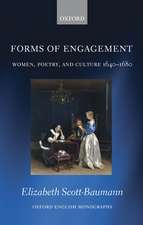Staging Pain, 1580–1800: Violence and Trauma in British Theater
Autor Mathew R. Martin Editat de James Robert Allarden Limba Engleză Hardback – 6 aug 2009
Preț: 1057.89 lei
Preț vechi: 1290.10 lei
-18% Nou
Puncte Express: 1587
Preț estimativ în valută:
202.43€ • 211.78$ • 168.16£
202.43€ • 211.78$ • 168.16£
Carte tipărită la comandă
Livrare economică 02-16 aprilie
Preluare comenzi: 021 569.72.76
Specificații
ISBN-13: 9780754667582
ISBN-10: 0754667588
Pagini: 232
Dimensiuni: 156 x 234 x 14 mm
Greutate: 0.54 kg
Ediția:1
Editura: Taylor & Francis
Colecția Routledge
Locul publicării:Oxford, United Kingdom
ISBN-10: 0754667588
Pagini: 232
Dimensiuni: 156 x 234 x 14 mm
Greutate: 0.54 kg
Ediția:1
Editura: Taylor & Francis
Colecția Routledge
Locul publicării:Oxford, United Kingdom
Cuprins
Contents: Introduction: staging pain, Mathew R. Martin and James Robert Allard; Part I Traumatic Effects: 'This Tragic glass': tragedy and trauma in Tamburlaine Part 1, Mathew R. Martin; 'Uncollected man': trauma and the early modern mind-body in The Maid's Tragedy, Zackariah C. Long. Part II Pedagogies of Pain: 'These were spectacles to please my soul': inventive violence in the Renaissance revenge tragedy, Annalisa Castaldo; A 'bracing' moment: Reynolds' response to Boswell and Burke on the aesthetics and ethics of public executions, William Levine. Part III Bodies (Im)Politic: Radical pity responding to spectacles of violence in King Lear, John D. Staines; Cutting, branding, whipping, burning: the performance of judicial punishment in early modern England, Sarah Covington; Tortured bodies, factionalism and unsettled loyalties in Settle's Morocco plays, Susan B. Iwanisziw. Part IV Spectacular Failures: Lavinia's rape: reading the Restoration actress's body in pain in Ravenscroft's Titus, Kara Reilly; Sympathy pains: filicide and the spectacle of male heroic suffering on the 18th-century stage, Cecilia A. Feilla; Joanna Baillie and the theater of consequence, James Robert Allard; Bibliography; Index.
Recenzii
'An impressive contribution to the study of early modern drama and its cultural contexts, this collection richly explores the uses of pain in the communal space of the theater to fashion identities, confront collective wounds, and rework traumatic histories, while also challenging us to think more carefully about the ways early modern stagings of trauma both resist and resonate with modern theoretical concepts.' Deborah Willis, University of California, Riverside, USA ’Interesting, but specialized...Recommended.’ Choice
Notă biografică
James Robert Allard and Mathew R. Martin are both Associate Professors in the Department of English Language and Literature at Brock University, Canada.
Descriere
This collection foregrounds two crucial moments in the histories of pain, trauma, and their staging in British Theater: the establishment of secular and professional theater in London in the 1580s, and the growing dissatisfaction with theatrical modes of public punishment by 1800. Whether focused on individual plays or broad concerns, these essays offer a new and important contribution to the increasingly interrelated histories of pain, the body, and the theater.
















